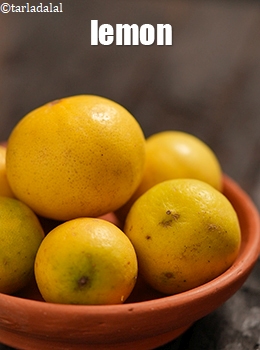
Also Known As
Citrus Limon, Limboo, Limbu, Lime, Nimbu, Sour lime.
What is Lemon, nimbu?
Lemon comes under the fruit category. It is round, bulgy and green to yellow coloured fruit. It has a tart taste, due to presence of citric acid and turns sweeter on maturing.
These are ovoid or egg shaped, have sour to sweet taste, depending on their maturity. They have a nipple at the apex and may be slightly ribbed. When peeled, they give off a pleasant aroma from the oil glands. The skin may be thick or thin and the pulp is pale yellow coloured, fragmented, juicy and acidic. There are ovoid seeds present at the core.
Grated lemon rind
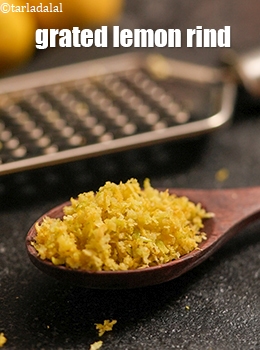
Lemon rind is the peel or the skin of lemon fruit. To remove lemon rind, wash the fruit thoroughly. Now with a scraper or a sharp knife, gently start peeling the skin from top to bottom. It should consist of only the thin yellow skin and not the white portion. It has a nice fragrance and is used as ingredient in baked goods. Grate it with a grater to make grated lemon rind. It should be stored in air tight container under refrigeration until its use. Its main purpose is for its flavor. You can also use it in garnishing a salad or as a dressing for a mock tail, which consists of lemon fruit.
Lemon juice
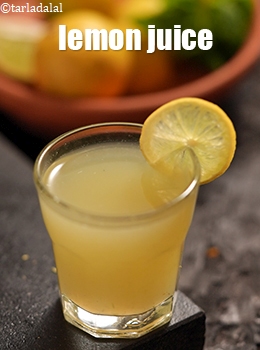
First wash it under running water. Now hold on a chopping board and cut into 2 halves using a sharp knife. Lemon juice is prepared by placing each lemon halve in a lemon squeezer and pressing it. You can also place a strainer on a bowl and then squeeze the lemon juice with one hand and collect the seeds in the strainer and discard them. Lemon juice, canned, concentrated, dehydrated or fresh is used to prepare carbonated beverages and lemonades. It may also be used to wash the bottom of a copper vessel.
Lemon leaf
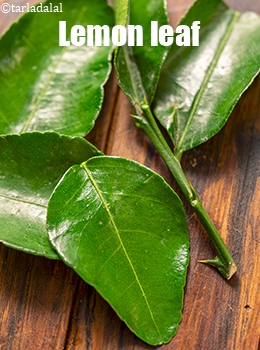
Lemon leaves are dark green, arranged alternatively on the stem of the lemon. Lemon leaves, also known as Kaffir lime leaves. They are widely used in Southeast Asian cuisine, particularly in
Thai Cuisine. Lemon leaves offer a unique citrusy aroma with a slightly peppery flavour, making them a valuable ingredient for enhancing the flavour of soups. It has a herbal use due to its cleansing nature.
Lemon rind
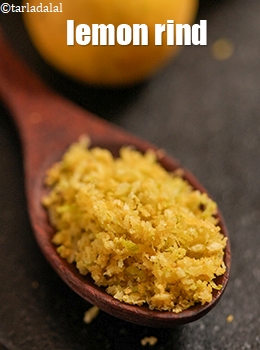
Lemon rind is the peel or the skin of lemon fruit. To remove lemon rind, wash the fruit thoroughly. Now place the lemon unpeeled on the holes of the grater and gently start peeling the skin from top to bottom. It should consist of only the thin yellow skin and not the white portion. It has a nice fragrance and is used as ingredient in baked goods. The lemon rind should be stored in air tight container under refrigeration until its use. Its main purpose is to flavour food. You can also use it in garnishing a salad or in dressing or for a mocktail, which consists of lemon fruit.
Lemon slices
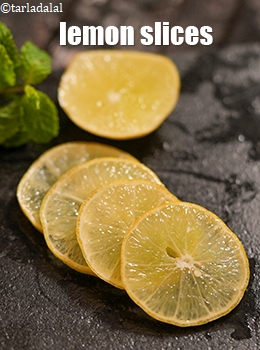
For slicing lemon, first wash it under running water. Now hold on a chopping board and with a sharp knife, start slicing it. The diameter may be around ½ inch, but it is not necessary that all the slices are exactly the same. Lemon may be thinly or thickly sliced as per the recipe requirement. The slices can be used on mocktail glasses as a garnish. Recipes like Lemon Pie, iced lemon treat can also be made using lemon slices.
Lemon wedges

First wash the lemon under running water. Now hold it on a chopping board. Now cut it unpeeled vertically into 2 halves on a chopping board. Now make 2-3 thick slices of both the halves, of the desired thickness. These are called the lemon wedges and are very much used in photography of food recipes and drinks.
How to select lemon, nimbu
Select the mature ones, which are yellow coloured and emit a nice fragrance. The thinner the peel or skin, the sweeter the fruit. Avoid buying the blemished or bruised fruits or those with any rotten smell.
There are a variety of lemons like the hybrid of orange lemon named as Meyer Lemon. It is less acidic or tart comparatively and named after Frank Meyer.
The seedless variety is Armstrong Lemon, in which there are no seeds.
Culinary uses of Lemon, nimbu, lemon juice in Indian cooking
Lemons used in Indian drinks
1. lemon apple juice recipe | lemon and apple juice benefits | apple lemon cooler | how to make apple and lemon juice |
lemon apple juice is a healthy, refreshing and energising Indian potion for early morning. Learn how to make apple and lemon juice.
To make lemon apple juice, add the apple cubes a few at a time in the juicer. Add the lemon juice and mix well. Add some crushed ice in 2 individual glasses and pour equal quantities of the juice over it. Serve apple lemon cooler immediately.
Lemon, limbu used in Indian pickles
1. A brilliant pickle that causes a burst of sweet and tangy flavours on your palate, the Nimboo ka Achaar is an all-time favourite, with fans spanning across generations! The preparation of this No Oil Lemon Pickle needs a bit of tact, but is not difficult if you follow these instructions properly. It is important to toss the lemons every day during the seven-day maturing period to avoid fungal growth. During this period, you must also take care to store the Sweet Lemon Pickle in a cool place away from heat, but not in the fridge.
2. Lemon Pickle : Oh, how versatile the humble lemon is, lending itself as beautifully to pickling candying, seasoning as to a variety of other uses.
Interestingly, most restaurants down South serve Lemon Pickle along with the 'meals', as the lemon is easy to procure and pickle, as well as liked by almost everybody.
Rice made with lemons, lemon juice
1. lemon rice recipe | South Indian lemon rice | chitranna rice | with 22 amazing images.
lemon rice recipe is a popular South Indian rice. lemon rice has a nice sour lemon taste. This is a easy and quick lemon rice recipe made with basic ingredients like lemon juice, boiled rice and Indian spices. Popular South Indian breakfast often is lemon rice also called chitranna rice often made with leftover rice.
2. Healthy Lemon Rice : This dish is ideal for the summer. Keep in mind the fact that the lemon juice has to be added judiciously to suit your palate so that you do not end up with a "khatta" or bland rice.
I enjoy this dish with rasam or just a bowl of salad. The lemon in the rice aids in the absorption of iron in your body due to its high vitamin C content.
Desserts with lemon
1. Eggless Lemon Cake : Bring together the soft succulence of the best of cakes with the citrusy scent and flavour of lemon, to make a perfectly delightful treat.
The cake dough is perked up with tangy ingredients like lemon juice and rind, which gives a fresh aroma and refreshing flavour to the cake.
Serve the Lemon Cake warm, with tea , to enjoy the pleasant citrusy tinge. For those who enjoy such fresh and tangy flavours, there are more recipes like the Lemon Butter Icing and Lemon Cheesecake .
· Lemons are used widely in many preparations.
· Because of the tart flavor, many lemon-flavored drinks and candies are available in the market.
· The skin can be peeled and used as toppings in desserts or cocktails.
· Lemons can pickled and stored.
· Lemon juice, canned, concentrated, dehydrated or fresh is used to prepare carbonated beverages and lemonades.
· Lemon slices are used in fish and meat dishes as a garnish.
· Also lemon can be used in making soups.
How to store Lemon, nimbu
Lemons have a good shelf life over all, but start deteriorating due to moisture loss or pests infestation. So it would be preferable to consume it as they ripen. It can be stored under refrigeration temperature, in perforated net bags and not in plastic bags. They stay fresh for 4-5 days after ripening in refrigerator. Green fruits may be held for 4 months or more, while the peel becomes yellow and thinner, the pulp juicier (6-80%) and the proportion of soluble solids higher (7-24%). Sometimes the degreening process is hastened commercially by exposing the fruit to ethylene gas, ethephon, or silane.
Health Benefits of Lemon, nimbu, lemon juice